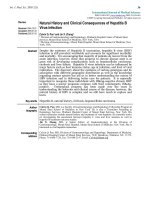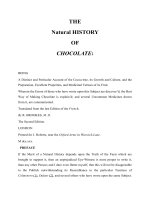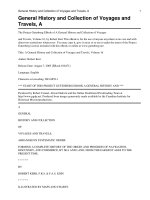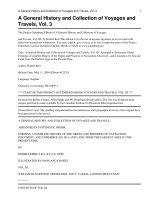diabetes pathophysiology, natural history and treatment
Bạn đang xem bản rút gọn của tài liệu. Xem và tải ngay bản đầy đủ của tài liệu tại đây (579.65 KB, 48 trang )
International Diabetes Center
International Diabetes Center
Diabetes:
Pathophysiology, Natural
History and Treatment
International Diabetes Center
International Diabetes Center
Glucose Metabolism and the
Natural History of Diabetes
•
Normal Glucose Metabolism
•
Type 1 Diabetes (IDDM) Autoimmune
•
Type 2 Diabetes (NIDDM) Insulin Resistant
and Insulin Deficient
•
Gestational Diabetes Mellitus (GDM)
Diabetes in Pregnancy
International Diabetes Center
International Diabetes Center
Normal Glucose Metabolism
Normal Glucose Metabolism
Peripheral Tissues
(Muscle and Fat)
Glucose
Liver
Insulin and glucagon
secretion
Glucose (glycogen)
storage and
production-Liver and
Kidneys
Pancreas
Nutrition
(carbohydrates)
Glucose (glycogen)
storage and
metabolism
International Diabetes Center
International Diabetes Center
Abnormal Glucose Metabolism
Abnormal Glucose Metabolism
Peripheral Tissues
(Muscle and Fat)
Glucose
Liver
Relative Insulin deficiency
(type 2, GDM) or no insulin
(type 1)
Improper regulation of
gluconeogenesis
(type 1 and type 2)
Pancreas
Nutrition
(carbohydrates)
Insulin
resistance
(type 2,
GDM)
International Diabetes Center
International Diabetes Center
Diabetes Pathophysiology:
Defects Associated with
Type 1, Type 2 and GDM
International Diabetes Center
International Diabetes Center
Natural History of Type 1 Diabetes
0
20
40
60
80
100
120
-6 -4 -2 0 2 4 6 8 10 12
Time (Age dependent)
Time (Age dependent)
Insulin Level
Autoimmune B Cell
destruction begins
Genetic background
At risk for Type 1 diabetes
Islet cell antibodies appear
% of Normal Function
% of Normal Function
International Diabetes Center
International Diabetes Center
Natural History of Type 1 Diabetes
0
20
40
60
80
100
120
-6 -4 -2 0 2 4 6 8 10 12
50
100
150
200
250
300
350
Time (Age
Time (Age dependent
)
)
Insulin Level
Fasting Glucose
Autoimmune B Cell
destruction begins
Genetic background
Genetic background
At risk for Type 1 diabetes
At risk for Type 1 diabetes
Islet cell antibodies appear
Glucose (mg/dL)
% of Normal Function
DM DX
DM DX
(11.1 mmol/L)
(7.0 mmol/L)
DM
DM
ONSET
ONSET
International Diabetes Center
International Diabetes Center
Natural History of Type 2 Diabetes
©2004 International Diabetes Center. All rights reserved
0
50
100
150
200
250
-10 -5 0 5 10 15 20 25 30
Years of Diabetes
Insulin Resistance
Insulin Level
Beta cell dysfunction
At risk for Diabetes
% of Normal Function
International Diabetes Center
International Diabetes Center
Natural History of Type 2 Diabetes
0
50
100
150
200
250
-10 -5 0 5 10 15 20 25 30
50
100
150
200
250
300
350
Years of Diabetes
Insulin Resistance
Insulin Level
Fasting Glucose
Post Meal Glucose
Developing
Diabetes
©2004 International Diabetes Center. All rights reserved
Glucose (mg/dL)
% of Normal Function
(11.1 mmol/L)
(7.0 mmol/L)
Beta cell dysfunction
International Diabetes Center
International Diabetes Center
Nucleus
Insulin
Glucose
Insulin
Receptor
Glucose
Transporter
(GLUT 4)
G
G
G
G
G
G
G
G
G
G
G
G
G
Adipose and muscle tissues require insulin for 90-95% of glucose uptake.
Liver, pancreas and brain do not require insulin for glucose uptake.
G
G
G
G
G
G
G
G
G
G
Insulin Signaling Pathway in
Insulin Sensitive Cells
©2004 International Diabetes Center. All rights reserved
International Diabetes Center
International Diabetes Center
Nucleus
Insulin Sensitive Cell
(Muscle or Fat)
Insulin
Glucose
Insulin
Receptor
Glucose
Transporter
(GLUT 4)
G
G
G
G
G
G
G
G
G
G
G
G
G
Insulin Resistance
©2004 International Diabetes Center. All rights reserved
International Diabetes Center
International Diabetes Center
Relative Insulin Deficiency
Natural History of Type 2 Diabetes
0
50
100
150
200
250
-10 -5 0 5 10 15 20 25 30
50
100
150
200
250
300
350
Years of Diabetes
Insulin Resistance
Insulin Level
Fasting Glucose
Post Meal Glucose
At risk for Diabetes
©2004 International Diabetes Center. All rights reserved
Glucose (mg/dL)
% of Normal Function
(11.1 mmol/L)
(7.0 mmol/L)
Beta cell dysfunction
International Diabetes Center
International Diabetes Center
Normal Beta Cell Function
Beta cells produce insulin and
store it in secretory vesicles
ATP
ATP
ADP
ADP
Pyruvate
Pyruvate
*Calcium channel
blockers do not effect
this channel
Voltage-gated
Calcium Channel*
Ca
Ca
++
++
Ca
Ca
++
++
G
G G
G
G
Glucose
Transporter
(Glut 2)
G
G
G
G
G
G
G
G
G
Potassium
Channel
K
+
K
+
X
X
K+ Channel Blocked- membrane becomes depolarized
K+ Channel Blocked- membrane becomes depolarized
©2004 International Diabetes Center. All rights reserved
International Diabetes Center
International Diabetes Center
Deficiency in Beta Cell Function
Beta cells produce insulin and
store it in secretory vesicles
ATP
ATP
ADP
ADP
Pyruvate
Pyruvate
Voltage-gated
Calcium Channel*
Ca
Ca
++
++
G
G G
G
G
Glucose
Transporter
(Glut 2)
G
G
G
G
G
G
G
G
G
Potassium
Channel
K
+
K
+
Initially, loss of glucose induced (first phase) insulin secretion
Eventually, reduction in beta cell mass
Note: Glucose toxicity
occurs when there is
chronic exposure to high
glucose levels
©2004 International Diabetes Center. All rights reserved
International Diabetes Center
International Diabetes Center
Natural History of Gestational Diabetes
0
50
100
150
200
250
300
<13 <27 27 29 31 33 35 38 40
Gestational Week
Insulin Resistance
Insulin Level
©2004 International Diabetes Center. All rights reserved
50
100
150
Fasting Glucose
Post Meal Glucose
Glucose (mg/dL)
% of Normal Function
Postpartum
(8.3 mmol/L)
(5.3 mmol/L)
International Diabetes Center
International Diabetes Center
Common to all Forms of Diabetes
•
Hyperglycemia
•
Hyperglycemia is related to microvascular
and macrovascular complications in Type
1 and Type 2; and to excess fetal growth
and complications of delivery in GDM
•
Treatment of hyperglycemia results in
improved outcomes
International Diabetes Center
International Diabetes Center
Treatment
MNT ORAL
AGENTS
INSULIN
Type 1
X X
Type 2
X X X
GDM
X X X
©2004 International Diabetes Center. All rights reserved
International Diabetes Center
International Diabetes Center
Diabetes Therapies
Medical Nutrition Therapy (Food Plan & Exercise)
Oral Agents
–
Insulin Secretagogues
•
Sulfonylureas- 1st, 2nd and 3rd generation
•
Repaglinide
•
Nateglinide
–
Biguanides - Metformin
–
Thiazolidinediones - Rosiglitazone and Pioglitazone
α-Glucosidase Inhibitors - Acarbose, Miglitol
Insulin
–
Bolus/pre-meal insulin (Regular and Rapid Acting – Lispro and Aspart)
–
Basal/background insulin (NPH, Lente, Glargine)
International Diabetes Center
International Diabetes Center
Treatment
MNT ORAL
AGENTS
INSULIN
Type 1
X X
©2004 International Diabetes Center. All rights reserved
International Diabetes Center
International Diabetes Center
Treatment: Type 1 Diabetes
0
20
40
60
80
100
120
-6 -4 -2 0 2 4 6 8 10 12
50
100
150
200
250
300
350
Time (Age
Time (Age dependent
)
)
Insulin Level
Fasting Glucose
Autoimmune B Cell
destruction begins
Genetic background
Genetic background
At risk for Type 1 diabetes
At risk for Type 1 diabetes
Islet cell antibodies appear
Glucose (mg/dL)
% of Normal Function
©2004 International Diabetes Center. All rights reserved
©2004 International Diabetes Center. All rights reserved
DM
DM
(11.1 mmol/L)
(7.0 mmol/L)
Insulin + Medical Nutrition Therapy
Type 1 Clinical Pathway
Entry Criteria Therapies
Lowers HbA1c
International Diabetes Center
International Diabetes Center
Fasting > 126 mg/dL (7 mmol/L)
Casual > 200 mg/dL (11.1 mmol/L)
Fasting > 126 mg/dL (7 mmol/L)
Casual > 200 mg/dL (11.1 mmol/L)
> 4%
Insulin Stage
INFUSION PUMP
Physiologic Insulin Stage 4
Basal/Bolus Insulin
RA(G) - RA - RA - G
©2004 International Diabetes Center. All rights reserved
International Diabetes Center
International Diabetes Center
Treatment
MNT ORAL
AGENTS
INSULIN
Type 2
X X X
©2004 International Diabetes Center. All rights reserved
International Diabetes Center
International Diabetes Center
Medical Nutrition Therapy
(Food Plan and Exercise)
•
Action
–
Appropriate distribution of
carbohydrate intake (carb.
counting)
–
Balance energy intake with
energy expenditure by
increased activity
•
Clinical Indicators
–
Insulin Deficiency/Insulin
Resistance
–
BMI - no range
–
HbA1c <8% as monotherapy or
as adjunct therapy with all
pharmacological agents
•
Side effects
–
None
•
Precautions and
Contraindications
–
Kidney Disease: low protein
diet for macroalbuminuria
–
Liver Disease: none
–
Heart Disease: assess fitness
before initiating activity
program
•
Pregnancy
–
Alter diet and activity to
promote normal fetal
development and avoid fetal
stress
International Diabetes Center
International Diabetes Center
Carbohydrate Counting
•
Emphasizes total amount of carbohydrate not the
source
•
Based on 3 food groups:
–
Carbohydrate
–
Meat and meat substitutes
–
Fat
•
15 grams of carbohydrate equals 1 “Carbohydrate
Choice”
•
Normally recommend 3-5 carbohydrate choices/meal
•
Effective with the “3Rs” Replace, Reduce, Restrict
International Diabetes Center
International Diabetes Center
Personal Food Plan
TO LOSE
WEIGHT
TO CONTROL
WEIGHT
FOR THE
VERY ACTIVE
WOMEN
2-3
CHOICES/ MEAL
3-4
CHOICES/MEAL
4-5
CHOICES/MEAL
MEN
3-4
CHOICES/ MEAL
4-5
CHOICES/MEAL
4-6
CHOICES/MEAL
Snacks: 0-2 choices/meal (if needed)
Snacks: 0-2 choices/meal (if needed)
©2004 International Diabetes Center. All rights reserved









